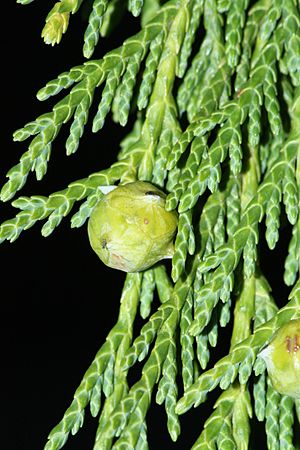Cupressus nootkatensis facts for kids
Quick facts for kids Cupressus nootkatensis |
|
|---|---|
 |
|
| Foliage and green cone, Mount Rainier National Park | |
| Conservation status | |
| Scientific classification | |
| Genus: |
Cupressus
|
| Species: |
nootkatensis
|
 |
|
| Natural range of Cupressus nootkatensis | |
| Synonyms | |
|
|
The Nootka cypress (scientific name: Cupressus nootkatensis) is a type of tree in the cypress family. It grows naturally along the coast of northwestern North America. You might hear it called by many other names, like yellow cypress, Alaska cedar, or Nootka cedar.
Its name, "nootkatensis," comes from the Nuu-chah-nulth people of Vancouver Island, British Columbia. Europeans first found this tree on their lands. The Nuu-chah-nulth were once known as the Nootka.
Contents
About the Nootka Cypress Tree
The Nootka cypress is an evergreen tree. This means it keeps its green leaves all year round. It can grow very tall, sometimes up to 40 meters (about 130 feet). Its branches often hang down, giving it a graceful look.
Leaves and Cones
The leaves are dark green and look like small scales, about 3 to 5 millimeters long. They grow in flat sprays. The tree's cones are small, usually 10 to 14 millimeters across. They have 4 to 6 scales. These cones take two years to fully grow, which is similar to other cypress trees.
Where Nootka Cypress Grows
This tree lives along the west coast of North America. You can find it from the Kenai Peninsula in Alaska all the way south to the Klamath Mountains in northern California. It often grows in wet areas in the mountains, sometimes near the tree line.
Oldest Nootka Cypress Trees
Some of the oldest Nootka cypress trees in the world are found in the Caren Range in British Columbia. One tree there was found to be 1,834 years old!
Nootka Cypress and Climate Change
In Alaska, this tree is often called "yellow cedar." Scientists have studied why many of these trees are dying. They found that the trees rely on thick coastal snow to protect their shallow roots from cold winters.
However, due to climate change, there is less snow, and it doesn't last as long. This leaves the tree roots open to freezing damage. This problem affects about 7% of where the tree grows. More trees are likely to die in the future as temperatures get warmer. The U.S. Fish & Wildlife Service is looking into whether this tree needs to be protected.
How People Use Nootka Cypress
The wood of the Nootka cypress is very special. It has been used for many things throughout history.
Building and Construction
The wood is strong and lasts a long time. It is good for building because it doesn't change shape much and can resist weather, insects, and contact with soil. It's easy to work with tools and takes a nice finish. When first cut, it has a bitter smell, but this goes away when it dries.
Because it is expensive, it's often used for special finished carpentry. This includes outside siding, roof shingles, decks, and cabinets. It was also used for shipbuilding.
Other Uses for the Wood
Nootka cypress wood is also used for saunas and even battery containers because it can resist acids. Long ago, people made paddles, masks, dishes, and bows from this wood.
Landscaping and Gardens
The tree's drooping branches make it look beautiful in parks and open spaces. It can also be grown as a tall hedge. It grows best in well-drained soil and places with cool summers. It can grow in sun or partial shade. Some people even use it for bonsai, which is the art of growing miniature trees.
Firewood
Nootka cypress wood makes excellent firewood. It burns very hot and creates long-lasting embers. Even a tree that has been dead for 100 years can still be used for firewood.
Nootka Cypress in Indigenous Cultures
The Nootka cypress is very important to the indigenous peoples of the Pacific Northwest Coast. They use it a lot, just like they use western red cedar. While western red cedar was used for big projects like houses and canoes, Nootka cypress was used for smaller carvings like dishes and tools.
The Raven and the Women
The Hesquiaht First Nation, a Nootka people, have a legend about how the Nootka cypress came to be. In the story, a raven meets three young women drying salmon. He asks if they are afraid of animals. They say no, except for owls. The trickster raven then hides and makes owl sounds. The terrified women run up the mountains. When they get tired, they turn into Nootka cypress trees.
This legend explains why the Nootka cypress grows on mountain sides. It also says why the bark feels soft like a woman's hair and the young trunk is smooth like a woman's body.
The First Killer Whale
In Tlingit culture, there is a story called Natsilane. It tells how a Nootka cypress tree was used to carve the world's first killer whale.
See also
 In Spanish: Falso ciprés de Nutca para niños
In Spanish: Falso ciprés de Nutca para niños









